Calibration of Equivalent Viscous Damping Expressions for Displacement-Based Design and Application to RC Frames
Abstract
1. Introduction
2. Materials and Methods
2.1. Modelling Equivalent Viscous Damping
2.2. Procedure for the Calibration of Equivalent Viscous Damping Equations
2.2.1. Methodology for the Analysis of Previous Formulations
- 1.
- Firstly, an effective period and a level of ductility are selected.
- 2.
- The equivalent damping factor () is estimated. In order to separate the influence of elastic damping from the hysteretic component, the initial elastic damping factor has been assumed to be .
- 3.
- The damped displacement spectrum is determined for the computed value of .
- 4.
- The displacement is then obtained from the damped spectrum, for the selected effective period (Figure 2).
- 5.
- For a given hysteretic model, the initial stiffness () and yield force () are defined by using , a mass value (), the effective period (), and the ductility level () as follows (Figure 3):where is the yield displacement, is the maximum force and r is the post-yield stiffness ratio.
- 6.
- The initial stiffness () can therefore be obtained as follows:
- 7.
- A nonlinear time-history analysis is performed for the considered earthquake record and the maximum displacement is then obtained ().
- 8.
- The ratio between the displacement obtained from time-history analysis and the one computed from the DDBD procedure (DR = ) is finally evaluated. In particular, a single value for each ground motion is obtained.
- 9.
- If the displacements are similar (within a 3% tolerance), the equivalent damping index can be kept unchanged, otherwise it is changed and the process is repeated from step two.
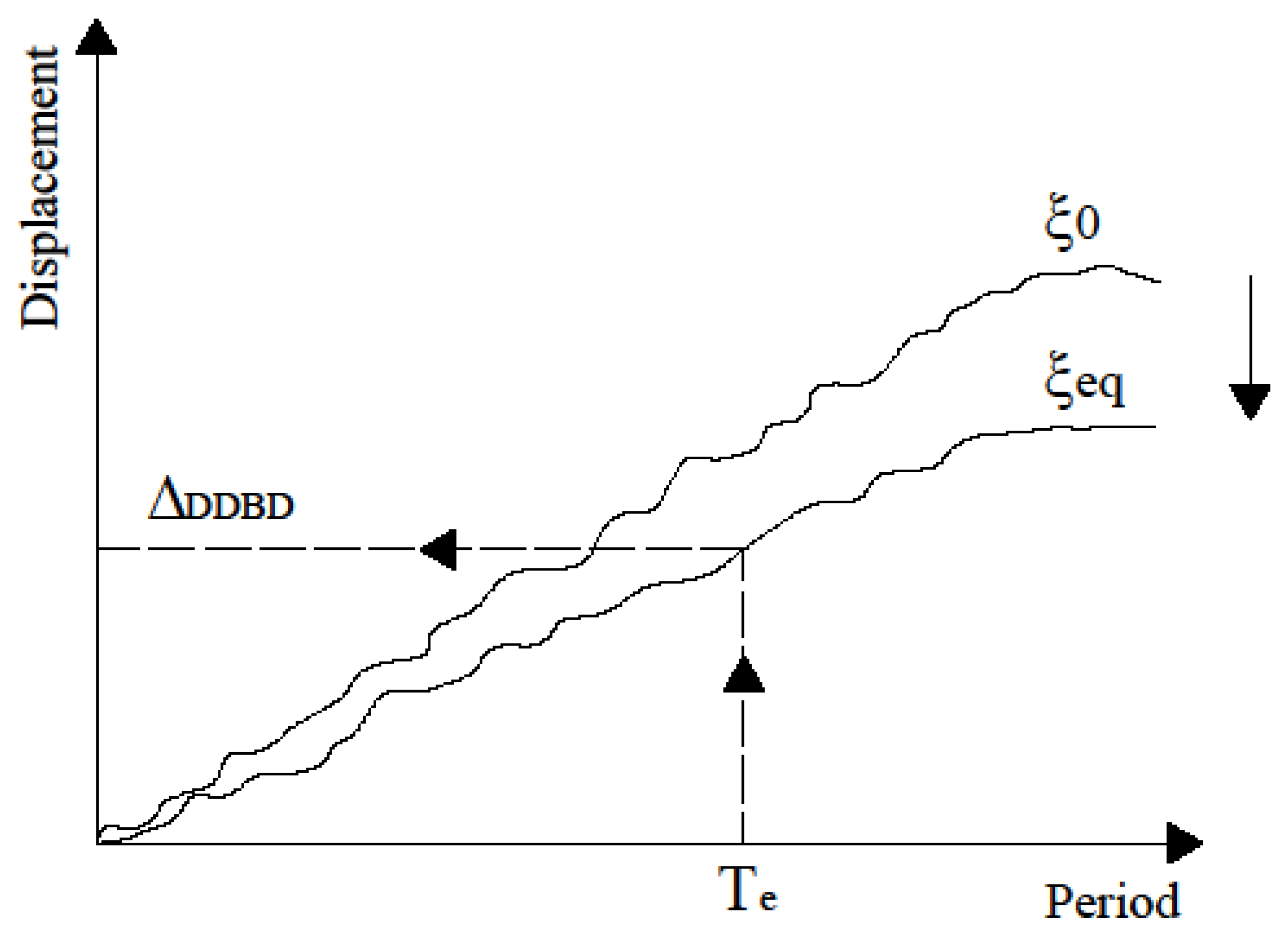
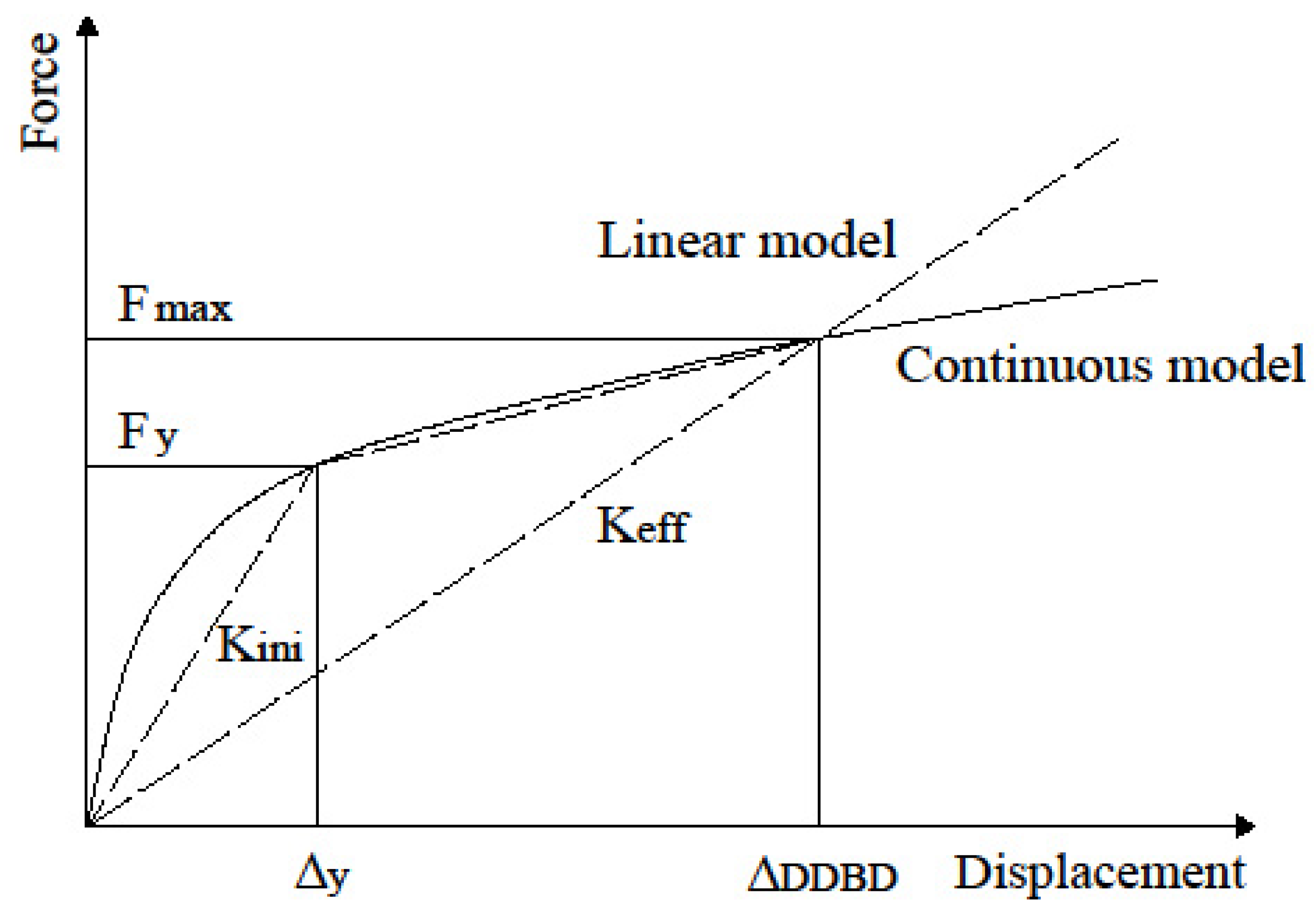
2.2.2. Hysteretic Models
2.2.3. Seismic Demand
3. Results
3.1. Evaluation of Existing Equivalent Viscous Damping Equations
3.1.1. Approach 1
3.1.2. Approach 2
3.2. Calibration of Equivalent Viscous Damping Equations
3.3. Verification of the Calibrated Parameters by Using Natural Accelerograms
3.3.1. Approach 1
3.3.2. Approach 2
3.4. Applications
3.4.1. Design Spectrum
3.4.2. Frame Description
3.4.3. Pushover Analyses
3.4.4. Nonlinear Time-History Analyses
4. Discussion
5. Conclusions
Author Contributions
Funding
Data Availability Statement
Conflicts of Interest
References
- Priestley, M.J.N. Myths and Fallacies in Earthquake Engineering—Conflicts between Design and Reality. Bull. N. Z. Soc. Earthq. Eng. 1993, 26, 329–341. [Google Scholar]
- Priestley, M.J.N. Performance based seismic design. In Proceedings of the 12th World Conference on Earthquake Engineering, Auckland, New Zealand, 30 January–4 February 2000. paper no. 2831. [Google Scholar]
- Priestley, M.J.N. Myths and Fallacies in Earthquake Engineering, revisited. The 9th Mallet Milne Lecture; IUSS Press: Pavia, Italy, 2003. [Google Scholar]
- Sullivan, T.J.; Calvi, G.M.; Priestley, M.J.N.; Kowalsky, M.J. The limitations and performances of different displacement based design methods. J. Earthq. Eng. 2003, 7, 201–241. [Google Scholar] [CrossRef]
- Muljati, I.; Asisi, F.; Willyanto, K. Performance of force based design versus direct displacement design in predicting seismic demands of regular concrete special moment resisting frames. In Proceedings of the 5th International Conference of Euro Asia Civil Engineering Forum, Surabaya, Indonesia, 15–18 September 2015; pp. 1050–1056. [Google Scholar]
- Castellanos, H.; Ayala, A.G. Trends in the displacement-based seismic design of structures, Comparison of two current methods. In Proceedings of the 15th World Conference on Earthquake Engineering, Lisboa, Portugal, 24–28 September 2012. 10p. [Google Scholar]
- Panagiotakos, T.B.; Fardis, M.N. Deformation-controlled earthquake-resistant design of RC buildings. J. Earthq. Eng. 1999, 3, 495–518. [Google Scholar] [CrossRef]
- Priestley, M.J.N.; Calvi, G.M.; Kowalsky, M.J. Displacement-Based Seismic Design of Structures; IUSS Press: Pavia, Italy, 2007. [Google Scholar]
- Shibata, A.; Sozen, M.A. Substitute-structure method for seismic design in R/C. J. Struct. Div. (ASCE) 1976, 102, 1–18. [Google Scholar] [CrossRef]
- Sullivan, T.J.; Calvi, G.M.; Priestley, M.J.N. Initial stiffness versus secant stiffness in displacement based design. In Proceedings of the 13th World Conference on Earthquake Engineering, Vancouver, BC, Canada, 1–6 August 2004. paper no. 2888. [Google Scholar]
- Dwairi, H.M.; Kowalsky, M.J.; Nau, J.M. Equivalent Damping in Support of Direct Displacement-Based Design. J. Earthq. Eng. 2007, 11, 512–530. [Google Scholar] [CrossRef]
- Kumbhar, O.G.; Kumar, R.; Farsangi, E.N. Investigating the efficiency of DDBD approaches for RC buildings. Structures 2020, 27, 1501–1520. [Google Scholar] [CrossRef]
- Landi, L.; Saborio-Romano, D.; Welch, D.P.; Sullivan, T.J. Displacement-based simplified seismic loss assessment of post-70s RC buildings. J. Earthq. Eng. 2020, 24 (Suppl. S1), 114–145. [Google Scholar] [CrossRef]
- Sullivan, T.J.; Saborio-Romano, D.; O’Reilly, G.J.; Welch, D.P.; Landi, L. Simplified pushover analysis of moment resisting frame structures. J. Earthq. Eng. 2021, 25, 621–648. [Google Scholar] [CrossRef]
- Jacobsen, L.S. Steady forced vibration as influenced by damping. Trans. ASME 1930, 52, 169–181. [Google Scholar]
- Miranda, E.; Ruiz-Garcia, J. Evaluation of the approximate methods to estimate maximum inelastic displacement demands. Earthq. Eng. Struct. Dyn. 2002, 31, 539–560. [Google Scholar] [CrossRef]
- Priestley, M.J.N.; Grant, D.N. Viscous Damping in Seismic Design and Analysis. J. Earthq. Eng. 2005, 9, 229–255. [Google Scholar] [CrossRef]
- Blandon, C.A.; Priestley, M.J.N. Equivalent viscous damping equations for direct displacement based design. J. Earthq. Eng. 2005, 9, 257–278. [Google Scholar] [CrossRef]
- Tarawneh, A.; Majdalaweyh, A.; Dwairi, H. Equivalent viscous damping of steel members for direct displacement based design. Structures 2021, 33, 4781–4790. [Google Scholar] [CrossRef]
- Sirotti, S.; Aloisio, A.; Pelliciari, M.; Briseghella, B. Empirical formulation for the estimate of the equivalent viscous damping of infilled RC frames. Eng. Struct. 2023, 288, 116196. [Google Scholar] [CrossRef]
- Mohebkhah, A.; Tazarv, J. Equivalent viscous damping for linked column steel frame structures. J. Constr. Steel Res. 2021, 179, 106506. [Google Scholar] [CrossRef]
- Farahani, S.; Akhaveissy, A.H.; Damkilde, L. Equivalent viscous damping for buckling-restrained braced RC frame structures. Structures 2021, 34, 1229–1252. [Google Scholar] [CrossRef]
- Augusto, H.; Castro, J.M.; Rebelo, C.; da Silva, L.S. Ductility-equivalent viscous damping relationships for beam-to-column partial-strength steel joints. J. Earthq. Eng. 2019, 23, 810–836. [Google Scholar] [CrossRef]
- Gu, A.; Shen, S.D. The influences of equivalent viscous damping ratio determination on direct displacement-based design of un-bonded post-tensioned (UPT) concrete wall systems. Smart Struct. Syst. 2022, 30, 627–637. [Google Scholar]
- Landi, L.; Tardini, A.; Diotallevi, P.P. A procedure for the displacement-based seismic assessment of infilled RC frames. J. Earthq. Eng. 2016, 20, 1077–1103. [Google Scholar] [CrossRef]
- Aloisio, A.; Alaggio, R.; Fragiacomo, M. Equivalent viscous damping of cross-laminated timber structural archetypes. J. Struct. Eng. 2021, 147, 04021012. [Google Scholar] [CrossRef]
- Dong, W.; Li, M.; Sullivan, T.; MacRae, G.; Lee, C.L.; Chang, T. Direct displacement-based seismic design of glulam frames with buckling restrained braces. J. Earthq. Eng. 2023, 27, 2166–2197. [Google Scholar] [CrossRef]
- Merino, R.J.; Perrone, D.; Filiatrault, A. calibrated equivalent viscous damping for direct displacement-based seismic design of suspended piping trapeze restraint installations. J. Earthq. Eng. 2022, 26, 8063–8091. [Google Scholar] [CrossRef]
- Merino, R.J.; Gabbianelli, G.; Perrone, D.; Filiatrault, A. Calibrated equivalent viscous damping for direct displacement based seismic design of pallet-type steel storage racks. J. Earthq. Eng. 2023, 27, 1012–1046. [Google Scholar] [CrossRef]
- EN 1998-1; Eurocode 8. Design of Structures for Earthquake Resistance—Part 1: General Rules, Seismic Actions and Rules for Buildings. European Committee for Standardization: Brussels, Belgium, 2005.
- Rosenblueth, E.; Herrera, I. On a kind of hysteretic damping. J. Eng. Mech. Div. 1964, 90, 37–48. [Google Scholar] [CrossRef]
- Gulkan, P.; Sozen, M. Inelastic response of reinforced concrete structures to earthquake motions. ACI J. Proc. 1974, 71, 604–610. [Google Scholar]
- Iwan, W.D.; Gates, N.C. The effective period and damping of a class of hysteretic structures. Earthq. Eng. Struct. Dyn. 1979, 8, 199–211. [Google Scholar] [CrossRef]
- Kowalsky, M.J. Displacement-Based Design—A Methodology for Seismic Design Applied to RC Bridge Columns. Master’s Thesis, University of California, Los Angeles, CA, USA, 1994. [Google Scholar]
- Dwairi, H.; Kowalsky, M. Investigation of Jacobsen’s equivalent viscous damping approach as applied to displacement based design. In Proceedings of the 13th World Conference on Earthquake Engineering, Vancouver, BC, Canada, 1–6 August 2004. paper no. 228. [Google Scholar]
- Otani, S. Hysteresis models of reinforced concrete for earthquake response analysis. J. Fac. Eng. 1981, XXXVI, 407–441. [Google Scholar]
- Gelfi, P. SIMQKE_GR, Version 2.7 (Software). Available online: https://gelfi.unibs.it/software/simqke/simqke_gr.htm (accessed on 3 March 2024).
- Zaharia, R.; Taucer, F. Equivalent Period and Damping for EC8 Spectral Response of SDOF Ring-Spring Hysteretic Models; JRC Scientific and Technical Reports; Institute for the Protection and Security of the Citizen, European Commission: Luxembourg, 2008. [Google Scholar]
- Seismosoft. SeismoSignal—A Computer Program to Process Strong-Motion Data (Software). 2016 Version. Available online: http://www.seismosoft.com (accessed on 3 March 2024).
- Benahmed, B.; Hammoutene, M.; Cardone, D. Effects of damping uncertainties on damping reduction factors. Period. Polytech. Civ. Eng. 2017, 61, 341–350. [Google Scholar] [CrossRef][Green Version]
- Heng, L.; Chen, F. Damping modification factors for acceleration response spectra. Geod. Geodyn. 2017, 8, 361–370. [Google Scholar]
- Cardone, D.; Dolce, M.; Rivelli, M. Evaluation of reduction factors for high-damping design response spectra. Bull. Earthq. Eng. 2009, 7, 273–291. [Google Scholar] [CrossRef]
- Sheikh, M.N.; Tsang, H.; Yaghmaei-Sabegh, S.; Anbazhagan, P. Evaluation of damping modification factors for seismic response spectra. In Proceedings of the Australian Earthquake Engineering Society Conference 201, Hobart, Australia, 15–17 November 2013; pp. 1–13. [Google Scholar]
- Charney, F.A. Nonlin V8.00 (Software); Advanced Structural Concepts Inc.: Blacksburg, VA, USA, 2010. [Google Scholar]
- Pacific Earthquake Engineering Research Center. PEER NGA Database. 2013. Available online: https://ngawest2.berkeley.edu/ (accessed on 3 March 2024).
- Calvi, G.M.; Sullivan, T.J. A Model Code for the Displacement-Based Seismic Design of Structures; IUSS Press: Pavia, Italy, 2009. [Google Scholar]
- SAP2000 Software, Version 24; Computers and Structures, Inc.: Berkeley, CA, USA, 2022.
- Takeda, T.; Sozen, M.; Nielsen, N. Reinforced concrete response to simulated earthquakes. ASCE J. Struct. 1970, 96, 2557–2573. [Google Scholar] [CrossRef]
- Pettinga, J.D.; Priestley, M.J.N. Dynamic behaviour of reinforced concrete frames designed with direct displacement-based design. J. Earthq. Eng. 2005, 9, 309–330. [Google Scholar] [CrossRef]



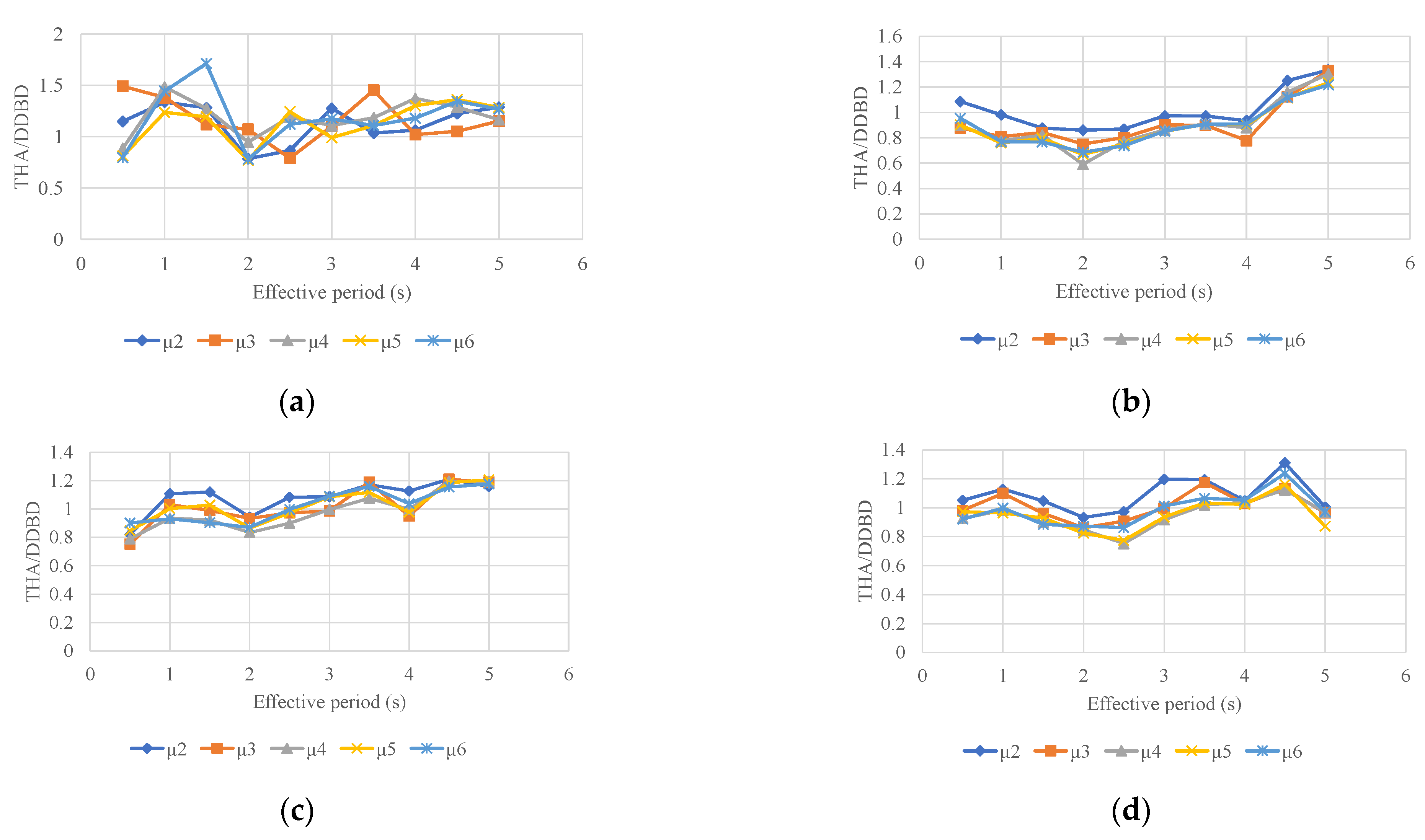
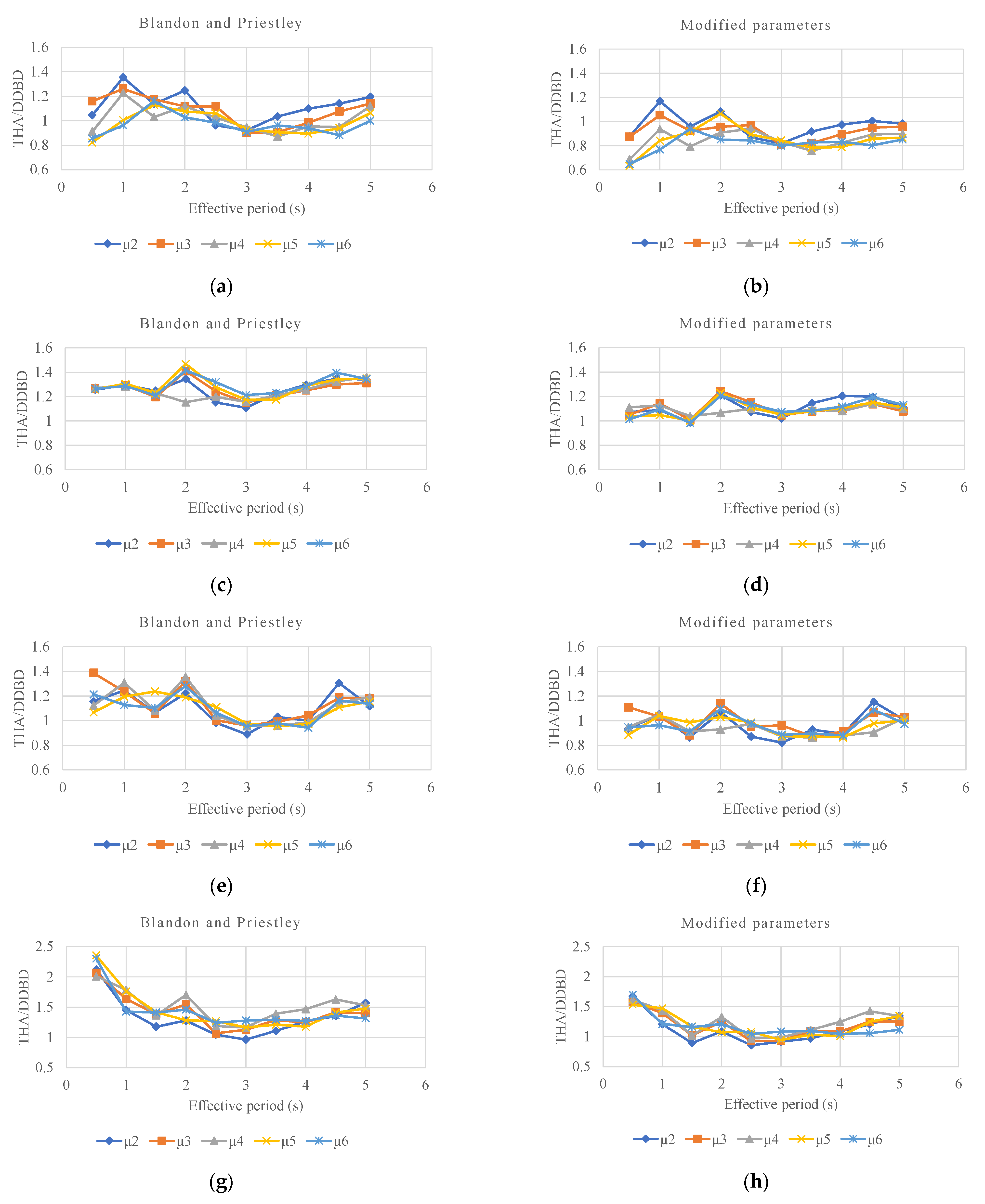
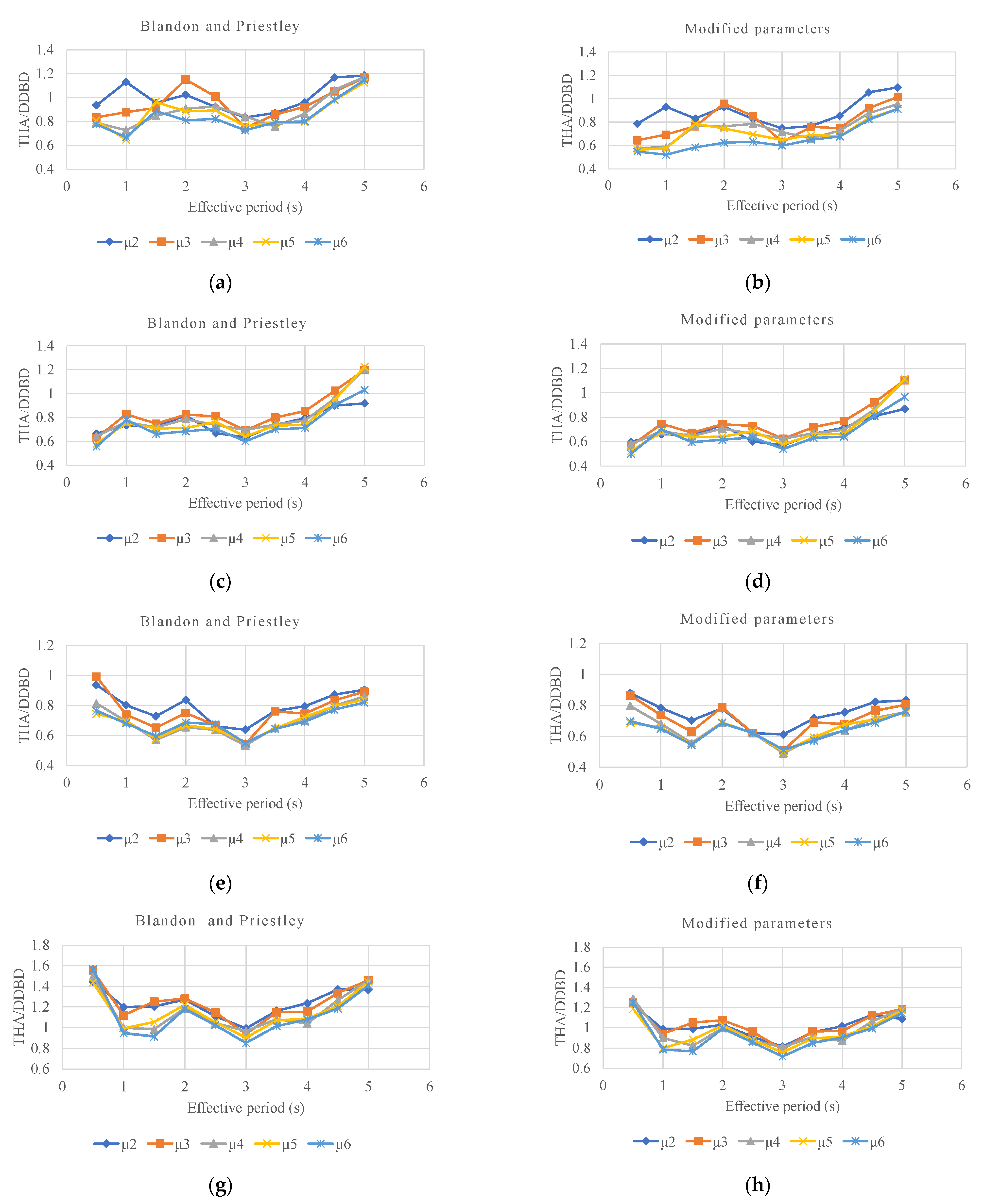
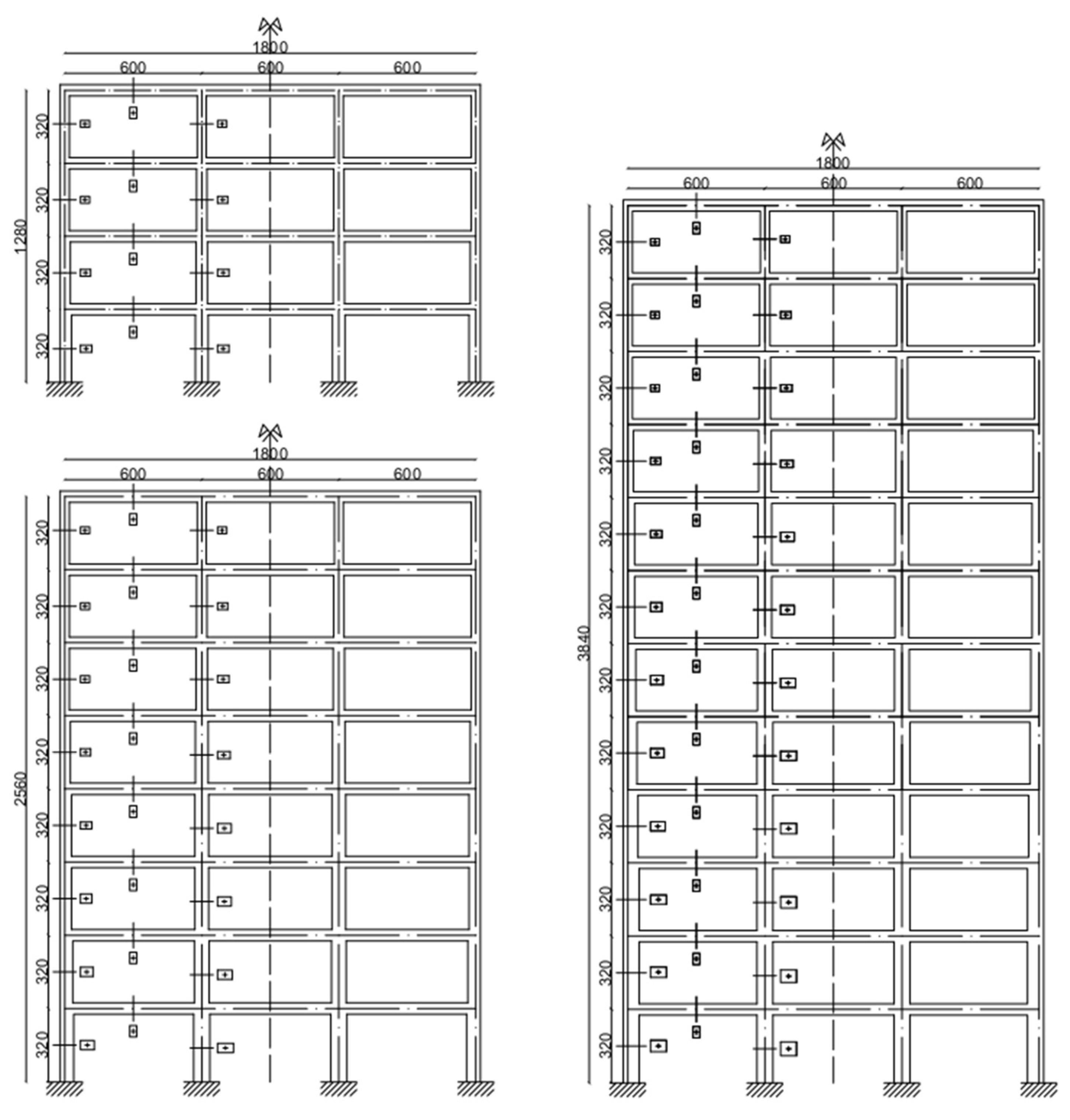
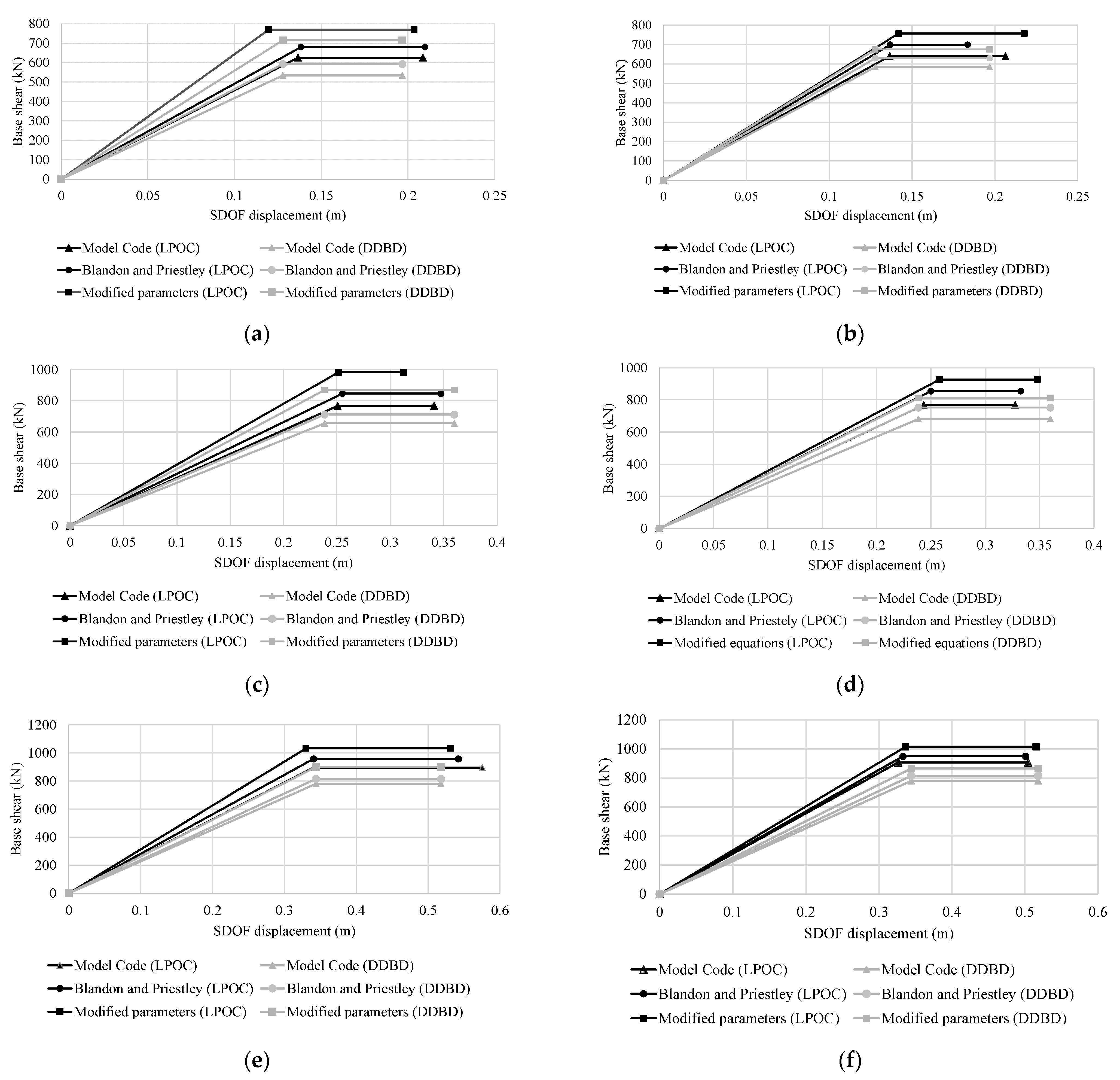
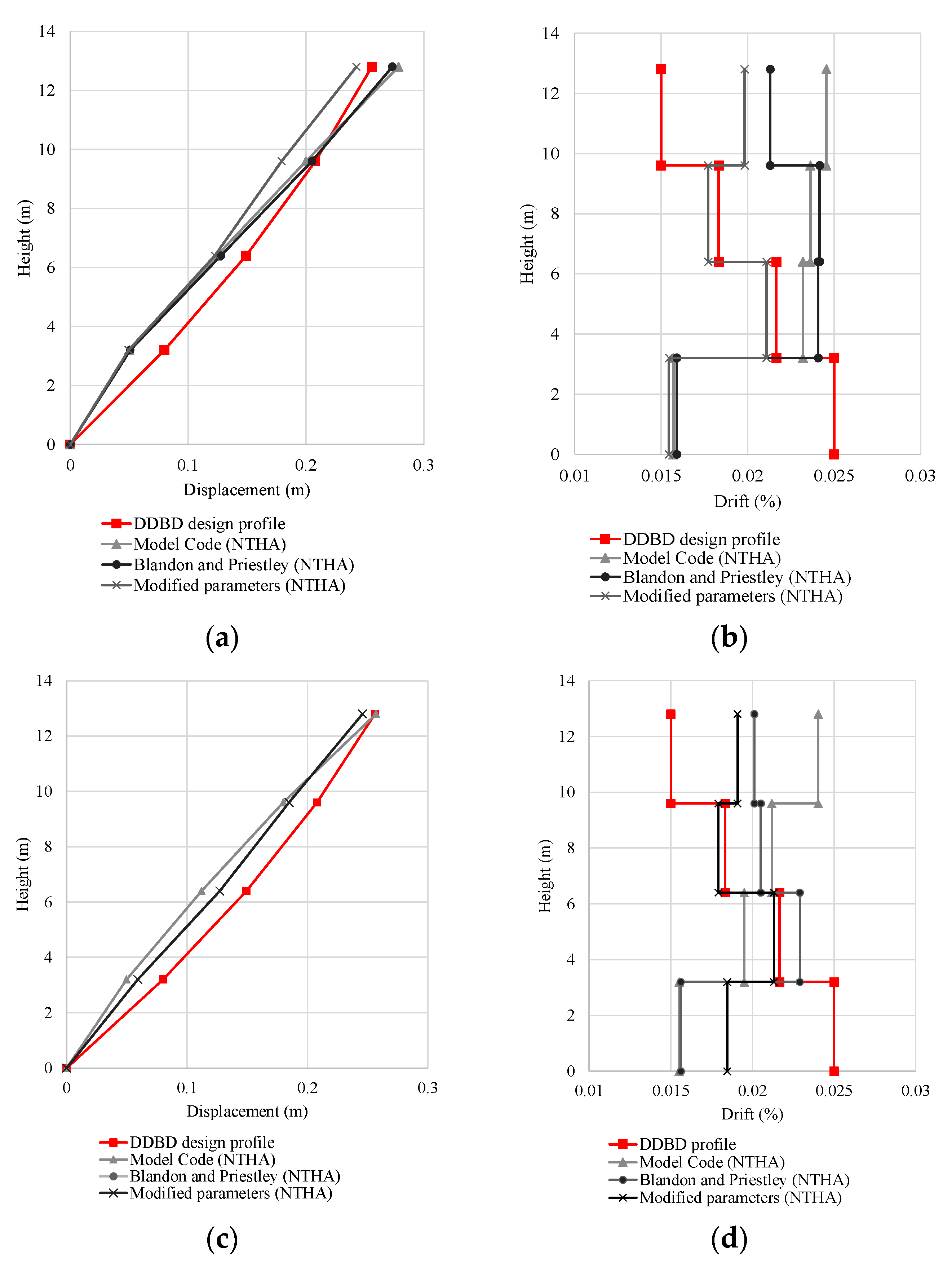

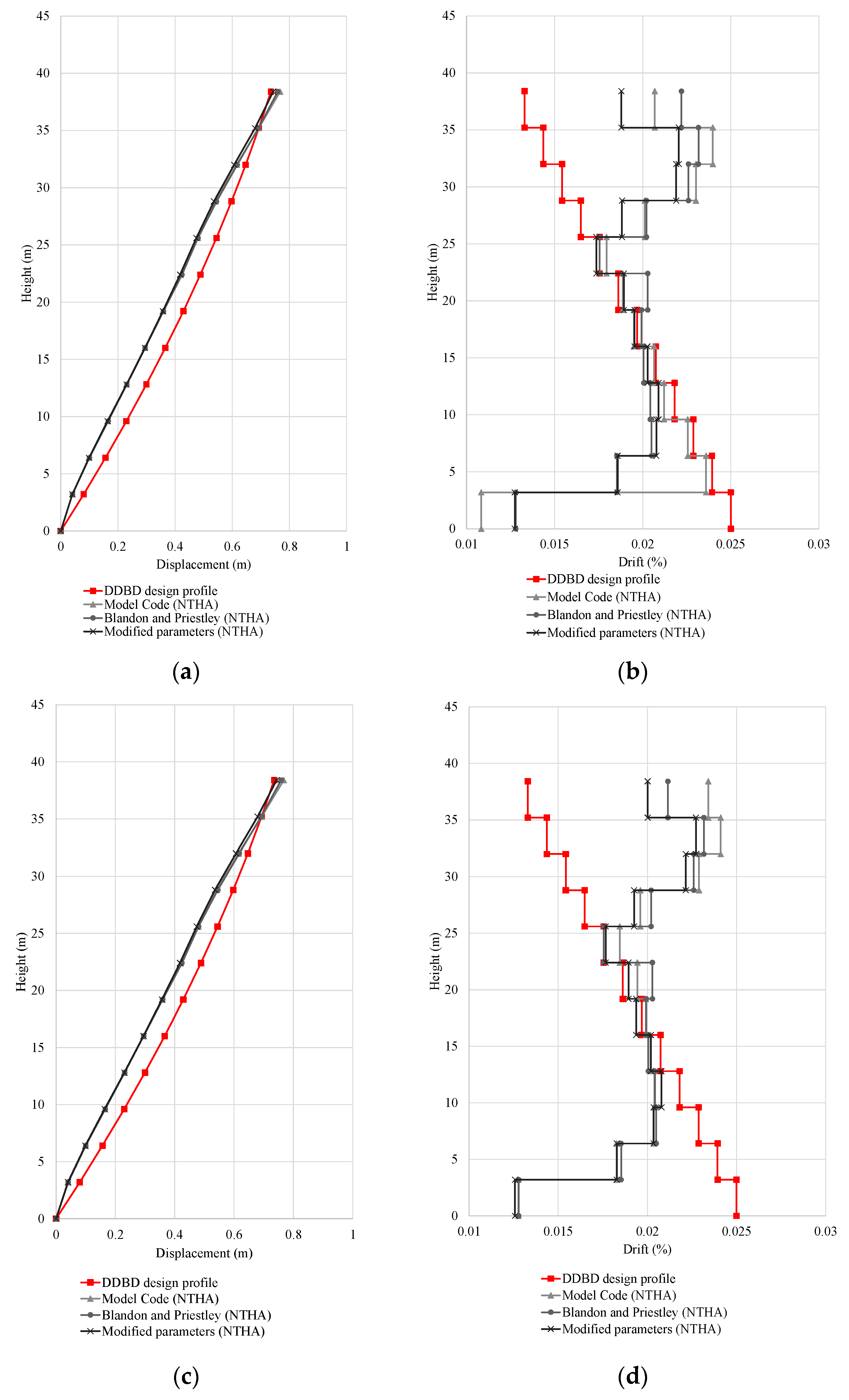
| Structural System | Formulation |
|---|---|
| Bilinear elasto-plastic system [31] | |
| Takeda model [32] | |
| Iwan model [33] | |
| Takeda model, α = 0.5 e β = 0, [34] | |
| Steel members [3] | |
| Concrete frame structures [3] | |
| Prestressed concrete frame or cantilever structures [3] |
| Limit State | |||
|---|---|---|---|
| OP | |||
| DL | |||
| LS | |||
| NC |
| Elastic P. Plastic | Bilinear | Takeda “Narrow” | Takeda “Fat” | ||
|---|---|---|---|---|---|
| Literature set by Blandon and Priestley [18] | a | 140 | 160 | 95 | 130 |
| d | 2 | 4 | 4 | 4 | |
| Set 1 (Approach 1) | a | 59 | 113 | 68 | 100 |
| d | 1.1 | 1 | 1 | 1.1 | |
| Set 2 (Approach 2) | a | 80 | 142 | 81 | 120 |
| d | 1.1 | 1 | 1 | 1.1 |
| Location | Year | Station | Name | PGA [g] | Arias Intensity | Significant Duration | Near/Far Field |
|---|---|---|---|---|---|---|---|
| San Fernando | 1971 | Hollywood, LA | NGA68 | 0.21 | 62.57 | 10.49 | far |
| Friuli | 1976 | Tolmezzo | NGA125 | 0.35 | 150.17 | 8.48 | far |
| Imperial Valley | 1940 | El Centro | NGA174 | 0.36 | 188.43 | 8.7 | far |
| Superstition Hills | 1987 | Poe Road | NGA725 | 0.45 | 201.44 | 13.81 | far |
| Landers | 1992 | Cool water | NGA848 | 0.28 | 116.89 | 10.43 | far |
| Duzce | 1999 | Bolu | NGA602 | 0.73 | 358.23 | 8.51 | far |
| Koacaeli | 1999 | Arcelik00 | NGA1148 | 0.22 | 27.81 | 11.01 | far |
| Chi-Chi | 1999 | CHY101 | NGA1244 | 0.35 | 223.20 | 30.38 | far |
| Imperial Valley | 1940 | Chiuahua 282 | NGA165 | 0.25 | 114.19 | 22.05 | near |
| Irpinia | 1980 | Sturno 00 | NGA292 | 0.25 | 114.78 | 15.05 | near |
| Nahanni | 1985 | Site2 | NGA495 | 0.49 | 82.11 | 9.87 | near |
| Loma Prieta | 1989 | Bran | NGA741 | 0.48 | 515.92 | 8.97 | near |
| Denali | 2002 | TAPS pump station | NGA2114 | 0.39 | 190.30 | 21.55 | near |
| Chi-Chi | 1999 | TCU102 | NGA1529 | 0.17 | 164.94 | 19.93 | near |
| Duzce | 1999 | Duzce | NGA1605 | 0.35 | 259.31 | 10.95 | near |
| 4 Storeys | 8 Storeys | 12 Storeys | ||||
|---|---|---|---|---|---|---|
| Inner Columns | Outer Columns | Inner Columns | Outer Columns | Inner Columns | Outer Columns | |
| 12 | 30 × 40 | 30 × 40 | ||||
| 11 | 30 × 45 | 30 × 40 | ||||
| 10 | 30 × 50 | 30 × 40 | ||||
| 9 | 30 × 55 | 30 × 45 | ||||
| 8 | 30 × 40 | 30 × 40 | 40 × 60 | 30 × 50 | ||
| 7 | 30 × 45 | 30 × 40 | 40 × 60 | 40 × 50 | ||
| 6 | 30 × 50 | 30 × 40 | 40 × 65 | 40 × 55 | ||
| 5 | 30 × 55 | 30 × 45 | 40 × 70 | 40 × 60 | ||
| 4 | 30 × 40 | 30 × 40 | 40 × 60 | 30 × 50 | 45 × 70 | 40 × 65 |
| 3 | 30 × 45 | 30 × 40 | 40 × 60 | 40 × 50 | 50 × 70 | 40 × 70 |
| 2 | 30 × 50 | 30 × 45 | 40 × 65 | 40 × 55 | 55 × 70 | 45 × 70 |
| 1 | 30 × 55 | 30 × 50 | 40 × 70 | 40 × 60 | 60 × 70 | 50 × 70 |
| Storeys | % | ||||||||
|---|---|---|---|---|---|---|---|---|---|
| Model Code 09 formulation | 4 | ||||||||
| 8 | |||||||||
| 12 | |||||||||
| Formulation and parameter set proposed by Blandon and Priestley [18] | 4 | ||||||||
| 8 | |||||||||
| 12 | |||||||||
| Formulation proposed by Blandon and Priestley [18] and calibrated parameter set 1 | 4 | ||||||||
| 8 | |||||||||
| 12 |
| Storeys | % | ||||||||
|---|---|---|---|---|---|---|---|---|---|
| Model Code 09 formulation | 4 | ||||||||
| 8 | |||||||||
| 12 | |||||||||
| Formulation and parameter set proposed by Blandon and Priestley [18] | 4 | ||||||||
| 8 | |||||||||
| 12 | |||||||||
| Formulation proposed by Blandon and Priestley [18] and calibrated parameter set 2 | 4 | ||||||||
| 8 | |||||||||
| 12 |
| DDBD | Approach 1 | Approach 2 | |||||
|---|---|---|---|---|---|---|---|
| Model Code | Blandon and Priestley | Modified Parameters | Model Code | Blandon and Priestley | Modified Parameters | ||
| 4 storeys | 2.5 | 2.45 | 2.42 | 2.11 | 2.4 | 2.29 | 2.13 |
| 8 storeys | 2.5 | 2.32 | 2.28 | 2.12 | 2.31 | 2.26 | 2.16 |
| 12 storeys | 2.5 | 2.4 | 2.32 | 2.19 | 2.34 | 2.32 | 2.27 |
Disclaimer/Publisher’s Note: The statements, opinions and data contained in all publications are solely those of the individual author(s) and contributor(s) and not of MDPI and/or the editor(s). MDPI and/or the editor(s) disclaim responsibility for any injury to people or property resulting from any ideas, methods, instructions or products referred to in the content. |
© 2024 by the authors. Licensee MDPI, Basel, Switzerland. This article is an open access article distributed under the terms and conditions of the Creative Commons Attribution (CC BY) license (https://creativecommons.org/licenses/by/4.0/).
Share and Cite
Landi, L.; Benfenati, C.; Quqa, S.; Bernagozzi, G.; Diotallevi, P.P. Calibration of Equivalent Viscous Damping Expressions for Displacement-Based Design and Application to RC Frames. Buildings 2024, 14, 738. https://doi.org/10.3390/buildings14030738
Landi L, Benfenati C, Quqa S, Bernagozzi G, Diotallevi PP. Calibration of Equivalent Viscous Damping Expressions for Displacement-Based Design and Application to RC Frames. Buildings. 2024; 14(3):738. https://doi.org/10.3390/buildings14030738
Chicago/Turabian StyleLandi, Luca, Cristiano Benfenati, Said Quqa, Giacomo Bernagozzi, and Pier Paolo Diotallevi. 2024. "Calibration of Equivalent Viscous Damping Expressions for Displacement-Based Design and Application to RC Frames" Buildings 14, no. 3: 738. https://doi.org/10.3390/buildings14030738
APA StyleLandi, L., Benfenati, C., Quqa, S., Bernagozzi, G., & Diotallevi, P. P. (2024). Calibration of Equivalent Viscous Damping Expressions for Displacement-Based Design and Application to RC Frames. Buildings, 14(3), 738. https://doi.org/10.3390/buildings14030738







